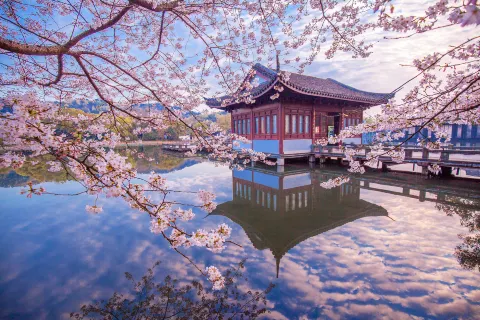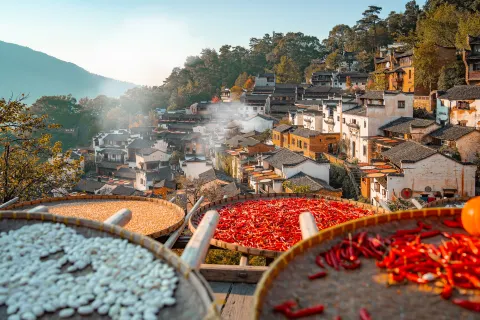https://https://uk.trip.com/toplist/tripbest/recommend/jing-county/best-things-to-do/10072616900000



Best Things to Do

Top 50 Best Things to Do near Jing County [2025]



Show All Photos

The Bund
4.8
/5
157583 reviews
10

Based on 19,611 reviews
The Bund Area | >100 km from downtown
Address: Zhongshan East Road, Huangpu District, Shanghai (Close to Huangpu River)
Recommended sightseeing time: 1–3 hours
Highlights:
Distant view of Lujiazui Finance and Trade Zone
Luminous views of colonial buildings
Saved by 13352 users128668 positive reviews
Verified user reviews



The river view is beautiful, but it's windy and a bit cold.
This place seems to be one of the synonyms for Shanghai. Strolling through it feels like traveling back in time to the past and present of Shanghai, with different scenery, different angles and different feelings on both sides of the Huangpu River.



Show All Photos

West Lake
4.7
/5
36676 reviews
10

Based on 7,561 reviews
West Lake, Lingyin Temple Scenic Area | >100 km from downtown
Phone +86057187977767
Address: West Lake Scenic Area, Xihu District, Hangzhou
Recommended sightseeing time: 0.5–1 day
Highlights:
Feed colorful koi fish
Listen to the melodious bells at Jingci Temple
Saved by 3797 users13462 positive reviews
Verified user reviews



To visit Lingyin Temple, you must purchase a ticket for the Feilai Peak scenic area. However, there are no package deals available inside; even if you do get a package deal, you still have to wait for a tour guide. It's suggested that a package deal option be added, since Lingyin Temple is a must-see when visiting Hangzhou; it's unlikely someone would go to Feilai Peak without visiting Lingyin Temple.
On an autumn weekend, West Lake is like an overturned palette of colors, revealing the gentlest side of Jiangnan. Compared to the hustle and bustle of midsummer, the lake and mountains at this time possess a greater sense of tranquility and depth, worthy of slow appreciation.
If you want to avoid the crowds, the western route of West Lake is an excellent choice. Yanggong Causeway is most pleasant in the early morning; the sycamore leaves turn yellow and fall, rustling underfoot, while the dawn redwoods on both sides gradually turn red, their reflections on the lake creating a misty, oil painting-like scene. Turning into the secluded Turtle Pool, the tallow tree leaves are even more vibrant than the red maples, egrets skim the water, and the sound of reed flutes adds to the serene beauty.
The autumn colors at Flower Harbor Park are incredibly layered: sycamores at the top, red maples in the middle, and red berries of nandina at the bottom, all arranged in a staggered pattern. From the lakeside promenade, you can frame the scene of Leifeng Pagoda and the boats dancing together, while the fragrance of osmanthus wafts through the air, refreshing and delightful. In the afternoon, a visit to Yuhu Bay reveals a mirror-like surface, reflecting the colorful forests and pavilions, creating an atmosphere reminiscent of a Monet painting.
Even the taste buds are imbued with autumn's charm. Lou Wai Lou's sweet lotus root with osmanthus blossoms is soft, chewy, and fragrant; street vendors offer roasted sweet potatoes with ginger tea to warm your hands and heart; and buying a jar of osmanthus honey allows you to bring the sweetness of West Lake home.
The only downside is the crowds at popular weekend spots; early arrivals are recommended to catch the first rays of sunlight. But when the autumn sun filters through the maple leaves and falls on your shoulders, and the fragrance of osmanthus drifts across the lake on the evening breeze, you'll understand why it's said, "Paradise on earth is nothing more than an autumn scene at West Lake."



Show All Photos

Huangshan Scenic Area
4.8
/5
62370 reviews
9.0
From SGD 17.36

Based on 3,135 reviews
The Peak Of Mount Huangshan | 66 km from downtown
Phone +8605592590999
Address: No. 1 Tangquan Road, Tangkou Town, Huangshan District, Huangshan City
Recommended sightseeing time: 1–2.5 days
Highlights:
Xihai Grand Canyon Hiking Challenge
Pines, rocks, clouds & hot springs
Saved by 1421 users42457 positive reviews
Verified user reviews



Excellent, a superb experience! The whole process was fulfilling and smooth, definitely worth experiencing again. Great, worth doing again!
For family trips, the cable car is a good option, and there are several lines that offer different views. Aside from the long queues due to the crowds, it's a pretty good option overall.
No.
4


Show All Photos

Vagoo Scenic Area
4.6
/5
18871 reviews
9.0
From SGD 25.58
Wang Xian Gu | >100 km from downtown
Phone +8607938467888
Address: 江西省上饶市广信区望仙乡636县道
Recommended sightseeing time: 1–2 days
Highlights:
Night lights illuminate Vagoo Scenic Area
Cliff buildings & mountain views
Saved by 3584 users16718 positive reviews
Verified user reviews



The scenery is beautiful, especially the night view, which is quite stunning. The view of the waterfall from the glass bridge is breathtaking! Although it was drizzling, there were still many people. We went in around 3 or 4 pm and didn't leave until 9 pm.
The room was clean and tidy, and the whole place was smart. There was a local restaurant on the first floor with delicious turtle. The cable car was free and they even provided hiking poles. The service was warm and attentive. It would have been perfect if the fermented bean curd and side dishes offered at breakfast had a non-spicy option.
No.
5


Show All Photos

Wuyuan Huangling
4.6
/5
18444 reviews
8.9
From SGD 33.25

Based on 37 reviews
Wuyuan Huangling/Tianjie | >100 km from downtown
Phone +8607937396003
Address: Huangling, Jiangwan Town, Wuyuan County, Shangrao City
Recommended sightseeing time: 2–3 hours
Highlights:
Unique autumn rooftop & windmill
Cable car: old & new views
Saved by 1117 users13958 positive reviews
Verified user reviews



The day I went was a beautiful sunny day, warm enough to wear short sleeves. Luckily, it rained the next day. It was peak season for autumn harvesting, so it's best to go during off-peak times. There were long queues at each photo spot. The whole trip wasn't long and wasn't tiring.
It was great. Easy to order, door-to-door pick-up and drop-off, familiar routes, safe and reliable, smooth round trip, detailed tour guide information, and enthusiastic service. The group meals were good, and not mandatory.
No.
6


Show All Photos

Humble Administrator's Garden (Zhuozheng Garden)
4.6
/5
76071 reviews
8.8
From SGD 12.79

Based on 2,348 reviews
Guanqian Street/Pingjiang Street | >100 km from downtown
Address: 178 Donbei St, Gusu District, Suzhou, Jiangsu, China, 215001
Recommended sightseeing time: 2–3 hours
Highlights:
Enjoy colorful scenery at the year-round flower show
World Heritage Site
Saved by 4339 users50471 positive reviews
Verified user reviews



It's worth visiting. The garden is well kept and has historical value.
As the foremost of the four great gardens, it attracts the most visitors and is the only one requiring real-name registration for entry. I specifically changed my Sunday reservation to Monday, and even arriving before 9 AM, the park was already quite crowded. Personally, I don't particularly like this style; it's excessively large and spacious, somewhat like a high-class park, lacking a sense of tranquility and scholarly atmosphere. Although the wisteria at the exit is a remnant and not in bloom, its cultural significance still allows one to feel a connection to Wen Zhengming's era through its branches and trunk.
No.
7


Show All Photos

Niushou Mountain Cultural Tourism Zone
4.7
/5
28341 reviews
8.7
From SGD 26.49

Based on 54 reviews
Niushou Mountain/Ginkgo Lake Park | >100 km from downtown
Phone +864001656363
Address: No. 18 Ningdan Avenue, Jiangning District, Nanjing
Recommended sightseeing time: 0.5–1 day
Highlights:
The Reclining Buddha statue wall in Usnisa Palace is breathtaking
Breathtaking Buddha statue wall
Saved by 2062 users23019 positive reviews
Verified user reviews



Niushou Mountain Scenic Area is a shining pearl of Nanjing's cultural tourism, well worth a visit. Its natural scenery and cultural heritage complement each other perfectly. Niushou Mountain, at 242.9 meters above sea level, boasts twin peaks that stand side-by-side like a celestial palace. Its scenery varies with the seasons: cherry blossoms in spring resemble snow, while autumn brings a misty haze, forming the "Niushou Misty Haze," one of the forty-eight scenic spots of ancient Jinling. It is also the birthplace of the Niutou Zen sect, preserving Tang Dynasty cliff carvings, the former fortress of Yue Fei's resistance against the Jin Dynasty, and the tomb of Zheng He, among other historical sites that tell tales of a thousand years of history. The architecture of the scenic area is also breathtaking. The Buddha Palace, built on an abandoned mine pit, blends ecological restoration with architectural art, winning both the Luban Award and the Zhan Tianyou Award. Inside, the Thousand Buddha Hall features a gilded dome that reflects beautifully in a mirror-like pool, exuding solemnity and magnificence. The Buddha Pagoda atop the mountain, designed in the Tang Dynasty style, echoes the Hongjue Temple Pagoda, offering panoramic views of Jinling city from its summit. Furthermore, the scenic area offers a variety of experiential activities. At the "Zen and Tea in Harmony" experience hall, visitors can feel the tea ceremony of the Tang and Song dynasties; at Wuzhen Hall, they can experience intangible cultural heritage handicrafts; and at Rulian Theater, the live-action performance "The Spring and Autumn Annals of Niushou" uses multimedia to tell a thousand-year-old story. The scenic area also thoughtfully offers the "Digital Niushou" mini-program, providing services such as audio guides, and transportation is very convenient. The only drawback is that the scenic area's ticket price is relatively high, and the large crowds during holidays may affect the visitor experience. However, overall, Niushou Mountain Scenic Area combines historical depth, aesthetic value, and modern services, making it a Jiangnan retreat where one can see history, touch the present, and gain insight into the future.
I stayed at the Hilton Niushou Mountain the night before. The next day, after breakfast, I took the hotel shuttle bus to the east gate of the scenic area. Nanjing residents can get half-price tickets now, which is very convenient. This is my third visit to Niushou Mountain. The autumn colors are very strong this time of year, and the scenery is beautiful. The underground palace is still as magnificent as ever and definitely worth a visit.
No.
8


Show All Photos

Lushan National Park
4.5
/5
18041 reviews
8.6
From SGD 29.23

Based on 146 reviews
>100 km from downtown
Phone +864009006162
Address: No. 19, Hexi Road, Guling Town, Lushan City, Jiujiang City
Recommended sightseeing time: 1–3 days
Highlights:
Maple Leaf Viewing at Lushan Botanical Garden in Autumn
360° view of Mount Lu
Saved by 269 users12618 positive reviews
Verified user reviews



It's a great place to escape the summer heat, and the prices for food and accommodation are quite reasonable at this time of year. As for meals, you can eat at the hotel, but you can also walk to town to eat, although that's a bit further. It's much, much cooler than down the mountain.
Although Lushan Mountain was crowded during the National Day Golden Week holiday, everything was well-organized. There were plenty of shuttle buses available, making it easy to get on and off at any time. The scenic area is vast with many attractions, so even during the Golden Week, it didn't feel crowded at all. Don't worry about the crowds.
No.
9


Show All Photos

Slender West Lake
4.7
/5
70051 reviews
8.5
From SGD 10.60

Based on 850 reviews
Slender West Lake Tourist District | >100 km from downtown
Phone +86051487370059
Address: No. 28, Dahongqiao Road, Yangang Lake Scenic Area, Yangzhou City
Recommended sightseeing time: 3–5 hours
Highlights:
Stamp art shows 24 Bridge's beauty
Five Pavilion Bridge with five pavilions
Saved by 337 users43581 positive reviews
Verified user reviews



My tour route was: Changdi Chunliu → Xuyuan Garden → Xiaojinshan Mountain → Diaoyutai (best photo spot!) → Wuting Bridge → White Pagoda → Twenty-Four Bridges. The most recommended experience was taking a traditional rowing boat ride. The boatwoman rowed slowly and gracefully, explaining the stories and anecdotes of the scenic spots on both banks in her soft Yangzhou dialect. The perspective from the water was completely different from that on land; I truly experienced what it meant to "drift through a painting."
The scenery of Slender West Lake is absolutely stunning; a stroll through it feels like stepping into a painting. The service is excellent, and the guides provide detailed explanations. The only drawback is the large number of tourists, so advance planning is essential. Overall, Slender West Lake is a classic scenic spot well worth a visit and is highly recommended for those who appreciate nature and culture.
No.
10


Show All Photos

Hongcun Village
4.5
/5
42898 reviews
8.5
From SGD 27.41

Based on 603 reviews
In Hongcun scenic area | 86.7 km from downtown
Phone +8605595541158
Address: No. 003, Qianjie Street, Hongcun Scenic Area, Hongcun Town, Yi County, Huangshan City
Recommended sightseeing time: 2–3 hours
Highlights:
Unique village layout & scenery
Unique village & exquisite carvings
Saved by 476 users26901 positive reviews
Verified user reviews



This was my second visit to Hongcun. This time it was more commercialized, with a huge number of tourists. The scenery was still quite nice. Anhui has many ancient villages, so I suggest visiting just one. The entrance fee is quite expensive. Although it's a three-day pass, who can spend three days in one place? This unintentionally raises the ticket price. I suggest improvements! This is our suggestion as tourists: lower the ticket price. Why charge such a high entrance fee for an ancient village?
Before visiting Hongcun, I was already drawn in by its reputation as a "village in a painting," and after seeing it in person, I found it even more beautiful than I expected! Buying tickets on the official website a day in advance saved me 20 yuan, and for only 94 yuan, I could enter the park repeatedly for three days – an incredible value!
I rushed into the scenic area at 6:30 am. There was no one vying for a good spot at the South Lake Bridge; the blue tiles and white walls were reflected on the calm lake surface. The ink-wash painting style from "Crouching Tiger, Hidden Dragon" seemed to come alive. A quick wide-angle shot with my phone was met with comments on social media asking if it was AI-generated. At 4 pm, I waited at Moon Pond. The sunset gilded the white walls, and the water reflected a "double moon spectacle." After 40 minutes of waiting, I finally got the best spot – the final photos were well worth the wait! The wood carvings at Chengzhitang are a must-see. Shining a phone flashlight at an angle, you can clearly see the eyelashes of the children in the "Hundred Children Celebrating Spring" scene – truly deserving of its title as the "Folk Palace Museum" of Huizhou.
For accommodation, I chose a guesthouse near the South Gate, just a few minutes' walk from the scenic area. The window offered a view of South Lake. The owners were incredibly welcoming, helping with my luggage and providing detailed explanations of the local customs and culture. They even made sure I arrived safely before I checked out. For food, I highly recommend the mildly spicy stinky mandarin fish at Deyuelou Restaurant. The skin is crispy, the flesh is shaped like garlic cloves – it smells pungent but tastes delicious! Also, try the fried hairy tofu sold by the old lady near the Wang Family Ancestral Hall, sprinkled with chili powder – crispy on the outside, tender on the inside, and incredibly flavorful.
Avoid these pitfalls: The cobblestone paths are extremely uncomfortable on your feet, so definitely don't wear high heels; a bowl of beef noodles inside the scenic area costs 50 yuan, which is not worth it. The "Laozaotou" restaurant outside South Lake offers a much better deal at 38 yuan, including stinky mandarin fish and braised pork with dried bamboo shoots; the "Huangshan Maofeng" tea sold for 10 yuan for 3 packs by the roadside is mostly stale tea. Look for the Hongcun Post Office at the South Gate exit, where you can sample the 68 yuan can of pre-rain tea.
Whether you're admiring the Hui-style architecture, taking stunning ink-wash style photos, or savoring authentic Hui cuisine, Hongcun is worth slowing down and savoring. I'm already missing the morning mist, the evening smoke, and the fresh aromas on my tongue. I'll definitely come back again!
1
2
3
4
5
About
Payment methods
Our partners
Copyright © 2025 Trip.com Travel Singapore Pte. Ltd. All rights reserved
Site Operator: Trip.com Travel Singapore Pte. Ltd.
Site Operator: Trip.com Travel Singapore Pte. Ltd.




